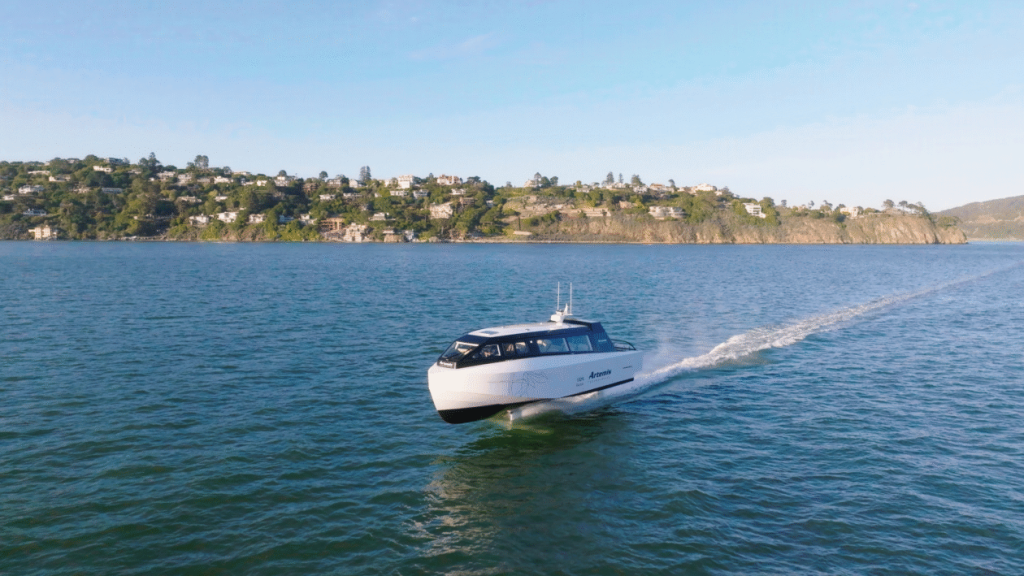Electric Ferry Service Could Connect Seattle and Tacoma for World Cup and Beyond
A New Vision for Puget Sound Transportation
Pierce County officials are envisioning a sleek, modern solution to connect Seattle and Tacoma by water – an electric hydroplane ferry service that could launch just in time for the 2026 World Cup. The ambitious project aims to transport tourists and locals between Puget Sound’s two largest cities, creating not just a transportation alternative but a scenic experience gliding across the waters of the Pacific Northwest. County leaders see this as more than a temporary solution for the influx of soccer fans; they hope to establish a permanent service that revives the region’s maritime heritage while embracing zero-emission technology. “This is an example of a legacy that we can leave this region that will promote tourism, promote economic development and promote movement around Puget Sound,” explained Pierce County Executive Ryan Mello during a recent presentation to Port of Tacoma officials.
The Plan and Its Partners
The proposed service would operate using two 29-passenger vessels leased from Prop SF, a company currently managing ferry services in San Francisco. These Artemis EF-12 Escape ferries, built by Irish company Artemis Technologies, would make eight daily round trips between the cities, accommodating up to 230 passengers per day. Pierce County has already committed $2 million from its lodging tax fund toward the $4 million needed to launch the service but is still seeking the remaining funds. Under the arrangement, Prop SF would handle vessel operations, maintenance, ticketing, marketing, and infrastructure needs. The county is working on a revenue-sharing agreement with Prop, with county proceeds being reinvested into the electric ferry program. Betty Baublits, Pierce County’s economic development director, described the vision as “bringing back the ‘Mosquito Fleet’ with this generation of boats,” referencing the privately owned ships that connected communities across Puget Sound more than a century ago.
Challenges and Unanswered Questions
Despite the enthusiasm surrounding the project, significant challenges remain with the compressed timeline targeting a Summer 2026 launch. Beyond the $2 million funding gap, the project must still identify suitable ferry terminal locations with appropriate parking and accessibility features. The installation of charging infrastructure represents another hurdle, and questions persist about who will pay for and own these shore-side facilities. The county has not yet specified passenger fare costs, which raised concerns among Port of Tacoma commissioners about accessibility and affordability. Commissioner Kristin Ang noted the luxurious interior of the vessels with their leather seats and questioned whether the service might cater primarily to “a certain class of people.” The ambitious timeline also worries some local stakeholders, including Dennis Joyce, director of investments for Tacoma Venture Fund, who cautioned: “This is a big project. It’s a big opportunity, and we need to give it the time necessary in order to be successful.” Tying the launch to the World Cup, he added, “is a really short time horizon.”
Transportation Context and Competition
The proposed ferry service would complement existing transit options between Seattle and Tacoma, which currently include Sound Transit’s commuter rail service and express buses. The ferry journey is expected to take 50-55 minutes each way – potentially longer than driving on Interstate 5, though Seattle’s notoriously unpredictable traffic could make the water route more reliable during peak congestion periods. The hydroplane ferries would be the only water-based public transit connecting these major cities, offering not just transportation but a distinctive experience for tourists and locals alike. While the travel time might not compete with driving on clear days, the ferry service would provide scenic views of Puget Sound and potentially allow passengers to avoid parking challenges in downtown Seattle, offering a stress-free alternative for commuters and visitors.
Previous Ferry Efforts and Regulatory Hurdles
Washington State has seen several electric ferry initiatives struggle in recent years. The state’s Department of Transportation has faced challenges with its plans to convert existing ferries to hybrid battery power and purchase new electric vessels, with both cost overruns and timeline delays. A proposed electric ferry to connect Anacortes and Guemes Island – a mere five-minute crossing – has similarly proceeded slowly. About a decade ago, Seco Development proposed a ferry service across Lake Washington between Seattle’s tech hub in South Lake Union and a Seco office development in Renton, but that project stalled amid bankruptcy issues. A significant challenge for these initiatives stems from federal regulations like the 1920 Jones Act and the Passenger Vessel Services Act of 1886, which require domestically manufactured vessels for passenger transportation within U.S. waters. These restrictions eliminate the option of purchasing potentially less expensive European-made ferries, complicating the economics of new service launches.
Manufacturing Possibilities and Future Vision
While Artemis Technologies builds its hydrofoils in Belfast, Northern Ireland, the company announced a manufacturing partnership with Seattle-based luxury yacht maker Delta Marine in February 2023. This connection raises the possibility of local vessel production, potentially creating jobs in the region – a point emphasized by Pierce County officials. However, David Tyler, Artemis co-founder and managing director for North America, declined to share specific details about where vessels for the Tacoma project would be built, what they would cost, or when they would be available, describing this as “currently commercially sensitive information.” Tyler did indicate that additional manufacturing locations beyond Seattle would be “announced soon,” suggesting potential expansion of production capacity. Despite the unanswered questions and tight timeline, County Executive Mello remains optimistic about leveraging the World Cup opportunity to create lasting transportation infrastructure: “Hosting such a significant world event causes some sense of urgency and helps cause some creativity about how we can take advantage of this moment for the benefit of the people who live here… and the businesses who have the responsibility of providing jobs and economic vitality for this region long after the games are gone.”


